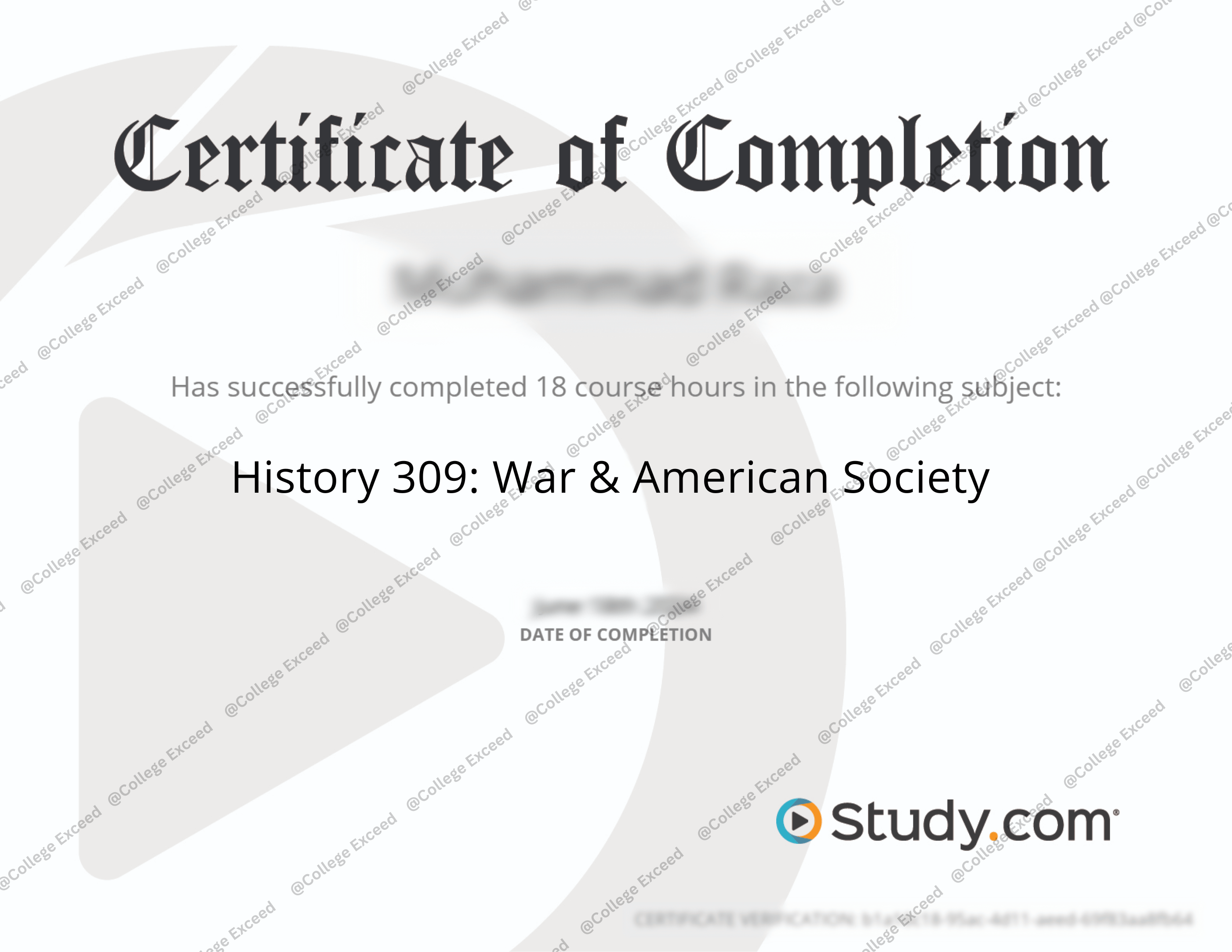
-
Gavin Walton
- October 23, 2024
Welcome to our article on study.com History 309: War & American Society – a class that precisely explores the wars that took place in America starting from the colonial period to the modern period. Welcome to the class prep and/or the crash course guide that you’ve been searching for. Whether it is history as a subject that interests you or it is just a subject that you have to study for your exams, this course is full of interesting facts on how most wars and conflicts have shaped American society. Military history is taught in this class from the War of 1812 to the war on terror and it’s hilarious and so is the teacher.
So don’t be scared away by the name of the course: War & American Society! This course is more than learning a few dates and important battles and tactics. It is about knowledge of the overall picture of how these wars influenced politics, culture, technology, and people’s lives. Here in this guide, we will dissect all that you will need to know and offer you strategies and materials to help you work smarter to prepare for the exam and come out top. So, sit back, find your favorite snack for studying, and let’s begin with this trip through American history becoming seamless and fun!
---

What to Expect from Study.com History 309 Class 📖
This course gives you an action-packed ride through the development of American society, politics, economy, and identity as analyzed by wars. As an American-focused class, it chronologically presents all the sources of crisis that occurred in the country and its involvement from the Native American clashes, First and Second World wars, the war on terror, and many more.
Major Conflicts and Their Impact: Be prepared to go through the history timeline with a focus extended to such historical battles as the Civil War, the World Wars, Cold War amongst others. The course does not focus mainly on the wars, but also on the effects of these wars on the social, political, and economic lives of the nation. You will also find out how each war shaped America as a nation and as a society; for the better or for worse. Spoiler alert: it’s precisely these topics: the Civil War, World War II, and the Vietnam War where you should expect a lot of questions, so make sure to study them thoroughly!
Key Figures and Policies: You will also learn more about the important personalities who shaped the American war strategies ranging from the presidential leaders such as Abraham Lincoln and Franklin D. Roosevelt to revolutionary warriors such as George Washington and Eisenhower. The course also includes certain policies and doctrines such as the Manifest Destiny, the Containment, and the Truman Doctrine, which helped to shape American foreign policies. It is important that one knows these figures and policies because many of them are usually sources of questions that appear in examinations.
Social and Cultural Effects of War: More significantly, the course covers the impacts of wars not only in military aspects but in American society as well as culture. You will take note of how conflicts brought significant changes to civil rights, gender roles, and economic policies. For instance, how World War II changed the status of women and their opportunities to earn money and the role of the Civil Rights Movement during the Cold War are important issues. These are not simply social transformations of interest, but rather these are fundamental social transformations on which the broader effects of war on American life depend.
There is not just learning the names of the leaders and dates of the wars: there is a correlation between the wars with the change in American society. Pay attention to how particular phenomena reoccur; for example, how wars are a start to the creation of technology or how propaganda is used in war to manipulate the public. Even at the end of the course, you will know not only what happened but why it happened and that’s the way to pass your exams!
Week-by-Week Study Plan to Ace Study.com History 309 Exam📝
Ready to conquer this course? Here’s a week-by-week guide to keep you on track and make your study sessions efficient and manageable. Follow this plan, and you’ll be well-prepared for the exam!
Week 1: Introduction & Early Conflicts
Focus on Chapters 1-3. Start with the foundation by understanding the earliest conflicts in American history, including wars with Native Americans and early colonial struggles. Pay attention to the key figures and the reasons behind these conflicts.
- Tasks: Watch the introductory lessons on study.com, take notes, and make flashcards for key terms.
- Extra Resources: Watch this quick video on the early American wars: YouTube – Crash Course US History #3.
Week 2: Revolutionary War & War of 1812
Dive into Chapters 4 and 5, focusing on the Revolutionary War and the War of 1812. Understand the causes, key battles, and the impact on the young nation’s development.
- Tasks: Create a timeline of major events and compare the impacts of both wars.
- Extra Resources: Use this Quizlet set on Revolutionary War Terms to drill key concepts.
Week 3: Civil War – Causes, Major Battles & Consequences
This week, focus on Chapter 7. The Civil War is a major exam focus, so spend extra time here. Study the causes, major battles like Gettysburg, and the war’s long-term effects on American society.
- Tasks: Break down the battles into causes, strategies, outcomes, and significance.
- Extra Resources: Check out the History Channel’s Civil War Battles Playlist.
Week 4: America’s Expansion & Imperialism
Chapter 9 is all about America’s push beyond its borders. Focus on the Spanish-American War, annexation of territories, and the impact on foreign policy.
- Tasks: Map out America’s territorial gains and understand the reasons behind them.
- Extra Resources: Watch PBS’s The Spanish-American War Documentary for a deeper dive.
Week 5: World Wars I & II
These chapters are packed with crucial info! Pay special attention to the causes, major battles, and homefront impacts of both wars. Don’t forget to review the post-war effects, especially on American society and foreign policy.
- Tasks: Create a Venn diagram comparing WWI and WWII.
- Extra Resources: Use Khan Academy’s WWI and WWII Overview to reinforce key points.
Week 6: The Cold War & Vietnam War
Focus on Chapters 12 and 13. Study the rise of the Cold War, key events like the Cuban Missile Crisis, and the Vietnam War’s causes and consequences.
- Tasks: Make a summary chart of the key policies during the Cold War.
- Extra Resources: Watch the Cold War Crash Course for an engaging recap.
Week 7: 21st Century Wars & Conflicts
Chapters 14 and 15 explore the War on Terror and recent conflicts. Understand the impact of events like 9/11 and the wars in Iraq and Afghanistan on modern American society.
- Tasks: Write a brief summary of how each recent conflict has shaped current U.S. foreign policy.
- Extra Resources: BBC’s Documentary on 9/11 provides context for the War on Terror.
Week 8: Review & Practice Tests
It’s crunch time! Go over all your notes, timelines, and flashcards. Take practice quizzes on study.com to identify weak areas. Focus on any key topics you’re struggling with and revisit those chapters.
- Tasks: Complete study.com’s practice exams and review incorrect answers carefully.
- Extra Resources: Try this Quizlet set for Final Exam Review to brush up on key concepts.
Follow this plan, keep up with your weekly tasks, and use the extra resources to deepen your understanding. By the end of these eight weeks, you’ll be more than ready to ace your study.com History 309: War & American Society exam!
---
Expand Your Knowledge with Free Study Resources📂
∙ YouTube Channels & Playlists
- CrashCourse U.S. History: This channel offers engaging and concise overviews of key historical events. Check out their playlists on American conflicts, wars, and societal changes. CrashCourse U.S. History
- History Channel Documentaries: These documentaries offer in-depth looks at specific wars, battles, and historical figures that are covered in History 309. They’re especially good for visual learners who want to see history come to life. History Channel
∙ Online Articles & Summaries
- Khan Academy History: The web can also be used to provide narrow coverage of many historical events, which are described in simple words with short quizzes at the end. Their lessons on the internet in U. S. History, World Wars, and the Cold War are especially informative. Khan Academy History
- BBC History: Provides balanced articles and videos on the crucial aspects of history such as the American Revolution and Civil War, World War I and II, and many others. It’s useful if one wants to get an international view of how such war affected America. BBC History
∙ Interactive Timelines & Maps
- Interactive Military History Maps: These tools allow one to get ideas such as the location of the battles, movement of troops, and events that took place in a view that a textbook cannot explain. Other websites that are available include HistoryAnimated which provides visitors with animated maps of significant battles ranging from the Revolution to the Second World War. HistoryAnimated
- The Library of Congress: They boast of their maps, photographs, and other primary materials that offer a glance at the events you are learning. Library of Congress
∙ Podcasts
- Hardcore History by Dan Carlin: Hardcore History by Dan Carlin: One of the show’s hosts, Dan Carlin, has made history in his podcast by focusing on large-scope historical occurrences in great detail, the World War I and II episodes are a must-listen. They are long though they are fluent and give perspectives you may not get from source books. Hardcore History
- You’re Dead to Me: A history podcast that mixes humor with serious historical analysis, making it perfect for revisiting historical events in an entertaining way. You’re Dead to Me
---
Key Topics to Focus On🔑
Grasping the key concepts in History 309: War & American Society can feel overwhelming, but breaking them down into digestible comparisons and real-world examples can make things clearer. Here are four crucial topics you should focus on, complete with tables and real-world applications to help you understand their significance:
- The Evolution of American Foreign Policy
It is necessary to explain how and in what way U. S. foreign policy has developed in order to follow this course. Here’s a comparison of key periods:
Period | Policy Focus | Key Example |
|---|---|---|
Pre-WWI | Isolationism | The U.S. avoided European alliances. |
Post-WWI | Internationalism | Creation of the League of Nations (failed for the U.S.). |
Cold War (1945-1991) | Containment of Communism | The Truman Doctrine and Marshall Plan. |
Post-9/11 | War on Terror and Preventative War | Invasion of Afghanistan and Iraq. |
Real-World Example: Even though America was isolationist before World War I and after it became internationalist getting involved in global politics as it does in the Middle East today.
- Civil Rights vs. Civil Liberties During Wartime
Most importantly, the dilemma between civil liberties and national security has to be well appreciated. As always, the war situation creates debates over the rights of the country to defend itself and the citizens’ right to privacy.
Concept | Description | Example |
|---|---|---|
Civil Rights | Rights ensuring equal protection under the law. | Desegregation of the armed forces. |
Civil Liberties | Fundamental freedoms protected from government interference. | Suspension of habeas corpus during the Civil War; internment of Japanese-Americans in WWII. |
Real-World Example: The recent changes in the degrees of surveillance occurred after September 11 when the Patriot Act was passed and set up rather strong controversies regarding privacy in the face of security.
- Technological Advancements in Warfare
Technological advancement tends to be boosted by war practices hence altering the war practices and societal transformation.
Era | Key Technology | Impact |
|---|---|---|
Civil War | Ironclads, telegraphs | Faster communication and naval dominance. |
WWI | Machine guns, tanks, chemical warfare | Increased battlefield casualties, trench warfare. |
WWII | Radar, atomic bombs | Enhanced air defense, end of war through nuclear means. |
Modern Warfare | Drones, cyber warfare | Precision strikes, new fronts in cyberspace. |
Real-World Example: Drones in the War on Terror are beneficial to America in the way that they lower the death toll for Americans but in doing so, raise the issue of remote control warfare and the loss of non-combatants’ lives.
- American Wars and Their Social Impact
These conflicts have shifted society in America affecting civil liberties and economic welfare of people, and even the position of the country in the international community.
War | Social Impact | Key Changes |
|---|---|---|
Civil War | Emancipation of slaves, Reconstruction challenges | Passage of the 13th, 14th, and 15th Amendments. |
WWII | Women entering the workforce, Civil Rights momentum | Rise of “Rosie the Riveter,” desegregation of the military. |
Vietnam War | Anti-war protests, questioning government trust | Rise of counterculture, changes in media reporting. |
War on Terror | Increased security measures, ongoing PTSD issues | Introduction of the TSA, increased veteran support services. |
Real-World Example: Protests against the Vietnam War increased the people’s skepticism of their government, and how future wars were fought by Leaders of the U.S.
Of these key topics, not only do you learn about history but also appreciate the impact of wars on the formation of the U. S and its place in the world. Well, for further reference, here comes a list of comparisons and examples that can help you steer through your courses and score an A in examinations.
---
Study.com History 309 FAQ❓
Q: To what extent, is the topic of foreign policy relevant to the exam?
Extremely important! The shift in the US foreign policy holds different cycles, therefore, understand the transition from isolationism to interventionism especially, during the Cold War and post-September 11.
Q: Do I need to memorize dates for the exam?
While exact dates aren’t usually the focus, knowing the timeline of major events and how they connect can help you better understand the progression of conflicts and their impacts.
Q: What resources can I use to better understand difficult concepts?
Besides your study.com materials, use free resources like Crash Course History on YouTube, Khan Academy for timeline overviews, and Quizlet for quick flashcard reviews.
Q: Are there essay questions on the exam?
Yes, you’ll likely encounter essay questions, so practice writing concise responses that directly address the question, using examples from key wars and policies to support your points.
Q: What strategies can I use in order to balance time during the exam?
Begin with the questions that you are confident with to gain some confidence and do not dwell much on any question; look at the time then switch if you can’t answer a particular question.
---
Wrapping It Up: Key Takeaways and Next Steps📄
History 309: War & American Society is more than a course; it is a fascinating history of the key wars that defined the United States and the entire world. Whether from the Civil War through to World War II and the Vietnam era to Afghanistan and Iraq, this class gives you an opportunity to view how wars shaped the United States of America both socially and politically, and on the world stage. That’s why sticking to the proposed study schedule, using additional materials, and paying extra attention to crucial subjects will help you succeed. When you write your final essay, make sure the goal of war is understood and elicits the change in the America that exists today including the study goal that is not limited to passing the examination but also learning the effects of war on America today. With purpose, a little effort in planning, and appropriate materials, you’ll be in good standing to excel in this class and learn how to critique history well. Avanti, good luck to you and the best greetings– Hello – don’t forget that you can make it!



